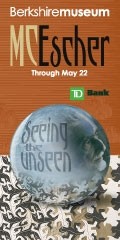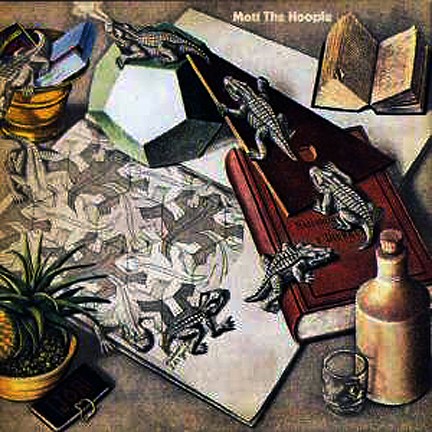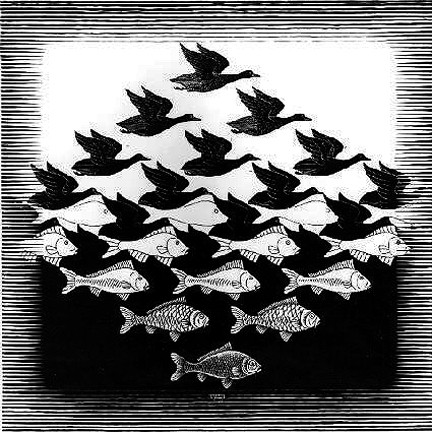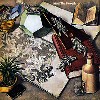MC Escher: Seeing the Unseen.
Berkshire Museum to May 22
By: Bob Fowler - Jan 21, 2011
Berkshire Museum's winter exhibition, a major show of the work of one of the 20th century’s most popular artists, MC Escher: Seeing the Unseen. This world premiere experience, conceived and curated by Berkshire Museum, offers a fresh perspective on an iconic artist, one who innovatively brought together graphic design, fine art, and an interest in natural history that makes him an excellent subject for a one-artist exhibition at Berkshire Museum.
MC Escher: Seeing the Unseen probes deeply into the real-world inspirations that guided the artist as he explored the outer reaches of his imagination—whether choosing lizards, swans and insects as his subjects, or creating mind-bending imagery reflecting universal laws found in mathematics. An immersive experience, it includes hands-on interactive stations providing the chance for visitors to find the fun in Escher's technique and explore his innovation in a personal way.
The exhibition is on view through May 22. It includes 120 original prints, woodcuts, drawings and sketches by Escher, including a major loan of 57 pieces from the collection of Boston Public Library, and other hard-to-find prints on loan from major Escher collectors and dealers. Museum admission is $13 for adults and $6 for children; Members enjoy free admission. Berkshire Museum is open from 10am to 5pm on Monday through Saturday, and noon through 5pm on Sunday. MC Escher: Seeing the Unseen is proudly sponsored by TD Bank.
“Escher was a true innovator in the way he synthesized natural science and the artistic impulse, which makes him the perfect artist to showcase in a one-artist show of this scope at Berkshire Museum,” says Executive Director Stuart Chase. “Our role in the community is to bring people together for experiences that combine natural history, science, and fine art. These all merge with Escher. Plus, he’s someone that children, their parents, and their grandparents can all enjoy on their own levels.”
Escher’s technical wizardry placed him in the tradition of the greatest European printmakers; his meticulously conceived and masterfully executed images prove endlessly appealing to the casual viewer and to students of all ages, while offering ample layers of detail and technique for the aficionado to appreciate.
His eminently accessible work, full of eye-popping imagery and fantastical scenarios, permeated popular culture to an extent virtually unheard of for living artists. Many of his iconic images were borrowed from and alluded to on everything from playing cards to dorm room posters, from the cover of a 2010 issue of The New Yorker to Mott the Hoople’s 1969 debut album.
MC Escher: Seeing the Unseen includes many of the artist’s best-loved pieces, including Reptiles, Belvedere, Three Worlds, Self Portrait in Spherical Mirror, Sky and Water I, and Waterfall. It places these unforgettable images in the context of other prints—many, like the epic scrolls Metamorphosis II and Metamorphosis III, rarely on public view—in which he worked out their key ideas.
This world premiere exhibition traces Escher’s progress from obsessively detailed Italian cityscapes to his discovery of the tightly interlocking shapes found in Spanish mosaics, which became the inspiration for the repeating images of birds, reptiles and fish that populate some of his most famous images. Obsessed with exploring precise ways of dividing the two-dimensional plane, and whimsically including self-conscious “clues” to the viewer that betray his awareness of the essential illusions at play, Escher pursued his vision with work that displays both an exacting sense of perfectionism and a wry sense of humor.
Peering behind the scenes at this iconic artist who let his work speak for itself, this fresh perspective includes a priceless look at Escher’s creative process, including some rare preparatory drawings on view alongside the finished work, as well as hand-cut woodblocks used by the artist to make prints.
The exhibition even includes some of Escher’s original pencils, pencil case, and drawing triangle. MC Escher: Seeing the Unseen also steps back to look at Escher’s impact on popular culture, with fun ephemera ranging from an issue of LIFE Magazine from 1961 to a small gallery of black light posters. Interactive stations provide the opportunity for visitors of all ages to explore the secrets at the heart of Escher’s work, from his iconic interlocking lizards to the possibilities of perspective.




